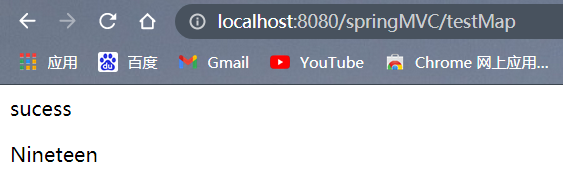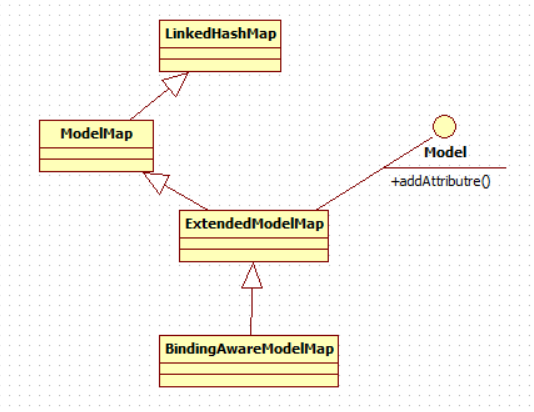【SpringMVC】域对象共享数据
使用ModelAndView向request域对象共享数据
index.html
<a th:href="@{/testModelAndView}">使用ModelAndView</a>

控制器
/**
* ModelAndView有Model和View的功能
* Model主要用于向请求域共享数据
* View主要用于设置视图,实现页面跳转
*/
@RequestMapping("/testModelAndView")
public ModelAndView success(){
ModelAndView modelAndView = new ModelAndView();
modelAndView.addObject("username","gonghr"); //向请求域共享数据
modelAndView.setViewName("success"); //设置视图名称,实现页面跳转
return modelAndView; //返回
}
success.html
sucess
<p th:text="${username}"></p>

使用Model向request域对象共享数据
index.html
<a th:href="@{/testModel}">使用Model</a> <br>
控制器
@RequestMapping("/testModel")
public String testModel(Model model){
model.addAttribute("company","JLU");
return "success";
}
success.html
sucess
<p th:text="${company}"></p> <br>

使用map向request域对象共享数据
index.html
<a th:href="@{/testMap}">使用Map</a> <br>
控制器
@RequestMapping("/testMap")
public String testMap(Map<String, Object> map){
map.put("age","Nineteen");
return "success";
}
sucess.html
sucess
<p th:text="${age}"></p> <br>

使用ModelMap向request域对象共享数据
index.html
<a th:href="@{/testModelMap}">使用ModelMap</a> <br>
控制器
@RequestMapping("/testModelMap")
public String testModelMap(ModelMap modelMap){
modelMap.addAttribute("major","software engineering");
return "success";
}
success.html
<p th:text="${major}"></p> <br>

Model、ModelMap、Map的关系
经过测试发现:除了ModelAndView的实现类是ModelAndView,Model、Map和ModelMap 的实现类都是BindingAwareModelMap。
Model、ModelMap、Map类型的参数其实本质上都是 BindingAwareModelMap 类型的
class of ModelAndView: class org.springframework.web.servlet.ModelAndView
class of Model: class org.springframework.validation.support.BindingAwareModelMap
class of Map: class org.springframework.validation.support.BindingAwareModelMap
class of ModelMap: class org.springframework.validation.support.BindingAwareModelMap
阅读ModeAndView的源码可以发现,ModeAndView和ModelMap是组合关系。下面是ModeAndView的部分源码。
public class ModelAndView {
@Nullable
private ModelMap model;
public ModelAndView() {
}
public ModelMap getModelMap() {
if (this.model == null) {
this.model = new ModelMap();
}
return this.model;
}
public ModelAndView addObject(String attributeName, @Nullable Object attributeValue) {
this.getModelMap().addAttribute(attributeName, attributeValue);
return this;
}
当ModeAndView调用addObject()方法时其实是调用ModelMap的addAttribute()方法,本质上与ModelMap是一样的。
各个类之间的关系如下:
public interface Model{}
public class ModelMap extends LinkedHashMap<String, Object> {}
public class ExtendedModelMap extends ModelMap implements Model {}
public class BindingAwareModelMap extends ExtendedModelMap {}

四种方式本质上都是调用的Model接口中的addAttribute方法
向session域共享数据
index.html
<a th:href="@{/testSession}">使用Session</a> <br>
控制器
@RequestMapping("/testSession")
public String testSession(HttpSession session){
session.setAttribute("message","session scope");
return "success";
}
success.html
<p th:text="${session.message}"></p> <br>

向application域共享数据
index.html
<a th:href="@{/testApplication}">使用Application</a> <br>
控制器
@RequestMapping("/testApplication")
public String testApplication(HttpSession session){
ServletContext application = session.getServletContext();
application.setAttribute("testApplication","hello,application");
return "success";
}
success.html
<p th:text="${application.testApplication}"></p> <br>

本文作者:gonghr
本文链接:https://www.cnblogs.com/gonghr/p/15202176.html
版权声明:本作品采用知识共享署名-非商业性使用-禁止演绎 2.5 中国大陆许可协议进行许可。




【推荐】编程新体验,更懂你的AI,立即体验豆包MarsCode编程助手
【推荐】凌霞软件回馈社区,博客园 & 1Panel & Halo 联合会员上线
【推荐】抖音旗下AI助手豆包,你的智能百科全书,全免费不限次数
【推荐】博客园社区专享云产品让利特惠,阿里云新客6.5折上折
【推荐】轻量又高性能的 SSH 工具 IShell:AI 加持,快人一步